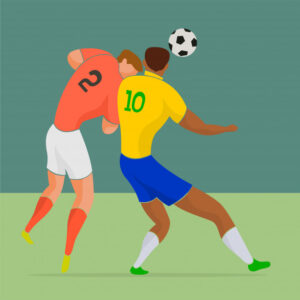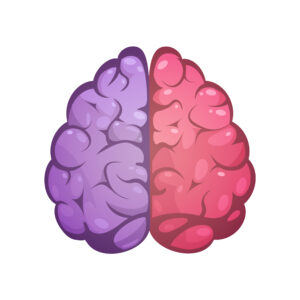What is a Traumatic Brain Injury?
A Traumatic Brain Injury is an injury to the brain that damages basic and standard brain function. Traumatic brain injury can be classified as moderate, mild, or severe.
The most common causes for traumatic brain injury is falls. There are other causes such as concussions in sports, car accidents, and being struck with objects. Traumatic brain injury can initially cause unconsciousness and comas, and over time change a persons behavior and their communication skills both verbally and nonverbally.

Prevalence
About 20% of adolescents in grades 7-12 are thought to have sustained a TBI, and men are 2.4 times as likely to sustain a TBI in their lifetime than women. Also, young white children and older poor African Americans are the most likely populations to sustain a TBI.
Video: Introduction and Right Hemisphere
Types of Damage
Right Hemisphere Damage:

A TBI in the right hemisphere most often affects pragmatics and social communication. The characteristics of right hemisphere damage can be sorted into three main categories: linguistic, nonverbal, and reading comprehension.
Linguistic Characteristics
- Inability to understand metaphors, sarcasm, jokes, or irony
- Difficulties in speech organization and cohesion
- Egocentric responses and an impaired theory of mind
- Inability to understand conversational cues or follow social conventions
Nonverbal Characteristics:
- Inability to understand gestures or nonverbal conversational cues
- Poor eye contact
- Trouble with turn taking
- Difficulties reading and understanding facial expressions
Reading Comprehension Characteristics:

- Difficulties in following the theme of the story
- Inability to understand metaphors or other non-literal phrases
- Significant difficulties in reading more advanced passages or books.
- Reduced reading speed and fluency
Video: Temporal Lobe Damage
Temporal Lobe Damage

A TBI in the Temporal Lobe affects memory and language comprehension. The Temporal Lobe includes Wernicke’s Area, which is the hub for all language comprehension and development, and can explain why these characteristics are observed.
- Difficulty with overall language comprehension in regular conversation
- Decreased listening comprehension
- Difficulty making inferences and using context
- Difficulty understanding figurative language (similes, metaphors, hyperboles)
- Loss of ability to process words and phrases with multiple meanings
- Loss of ability to process abstract concepts and phrases
Because Wernicke’s Area is the hub of comprehension, the effects of TBI in this region of the brain are all nonverbal.
Video: Frontal Lobe Damage
Frontal Lobe Damage
A Traumatic Brain Injury in the Frontal Lobe will directly affect memory and linguistic production. The Broca’s area will have deficits and speech and sound.
Linguistic Characteristics
- Pronouncing syllables
- Conversational synchrony
- Linguistic production
- Speech and Sound discrimination
Nonverbal Characteristics
- Issues with problem solving
- Damage working memory
- Reduced emotion
- Have problems understanding humor
Interventions

There are many interventions for right hemisphere damage, including group therapies, individual exercises, post-acute rehabilitation programs, and social skills training. Three particularly effective interventions for TBIs in all areas of the brain are interpersonal process recall, cognitive rehabilitation, and school interventions.
Interpersonal process recall involves a client and a specialist having a conversation while being videotaped. After this conversation, the client and their interventionist review the footage together and discuss it. During their discussion, they talk about the choices made by the client, the social cues it gave, and the feelings the client had in the discussion. They also use the tape as a tool to go back and reenact parts of the conversation where breakdowns occurred. This allows a client to fix their breakdown with the help of the interventionist.
Cognitive rehabilitation is a set of treatments that focuses on the temporal lobe damage and aims to increase one’s capacity to comprehend and interpret language, thus increasing their everyday conversational abilities.
- The restorative approach of this method focuses on neuron growth by repeated use of the neurons, causing an improvement in function
- The compensatory approach of this method creates strategies to help work around those impaired functions, and should only be used as a last resort, and if the restorative approach has not worked
- The most important part of this intervention is allowing the patient to be self aware of the work that is going on, which will allow them to focus in better on which aspects of their comprehension need the most help
- For more mild nonverbal TBIs, speech language pathologists are another very effective intervention, as they work individually with patients to create a plan with short and long term goals, using modified teaching and activities. These activities include modeling and feedback, visual matching, and activity based therapy, and help the patient improve comprehension over time
School interventions will have four specific cognitive impairments.
- Attention
- Memory
- Organization
- Writing
To deal with the cognitive impairments, students will have accommodations.
- Simplified classroom
- Headphones to help the student focus
- Unique calendar
- Rest periods during instruction
- Slower pace of instruction
Informational Video
https://www.youtube.com/watch?v=wlYiDxNcMdc
Additional Resources
https://www.cdc.gov/traumaticbraininjury/index.html
https://medlineplus.gov/traumaticbraininjury.html
Photo credits:
- Header: Image by Raman Oza from Pixabay
- Right brain image: Poster vector created by macrovector
- Books: Image by 200 Degrees from Pixabay
- Interventions: People vector created by pch.vector
- Frontal Lobe: Image by Juanella from pixabay
- Temporal Lobe: Image by Janulia on istockphoto
- Soccer Image: arammart on Freepik

